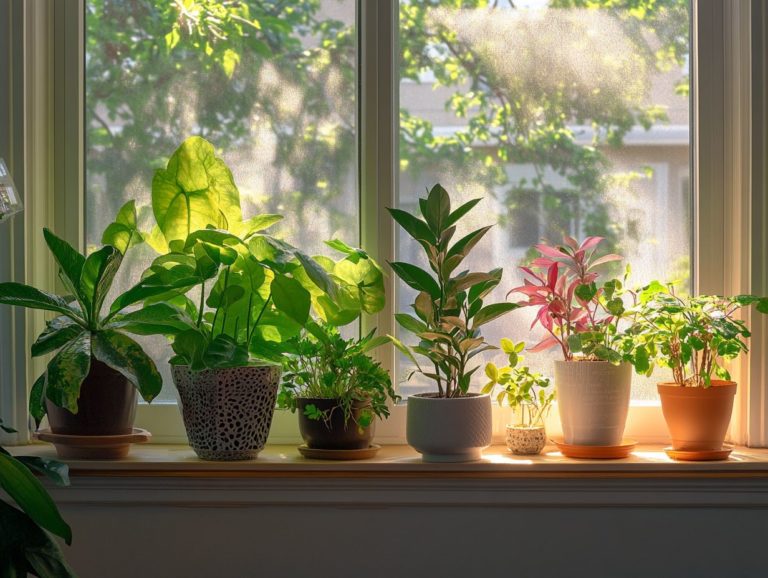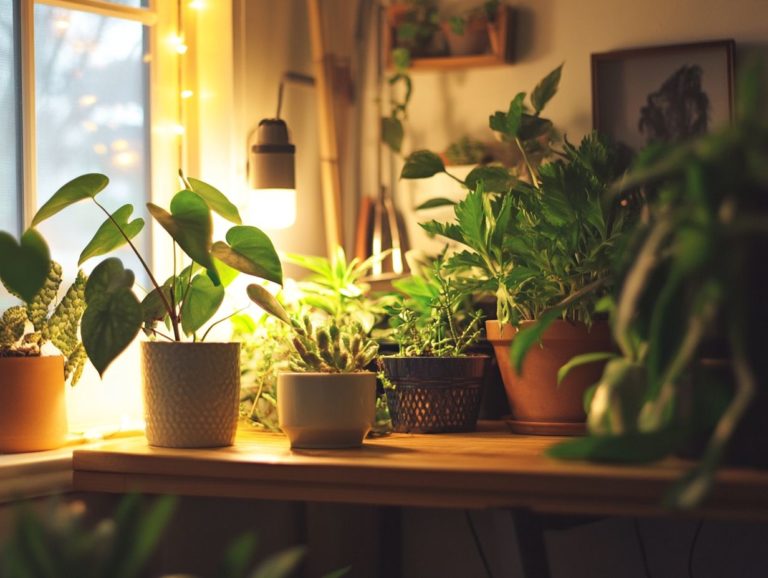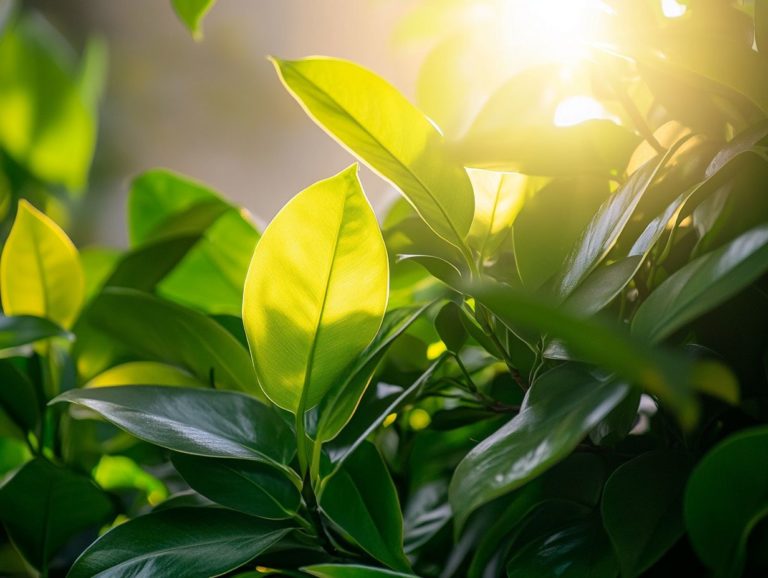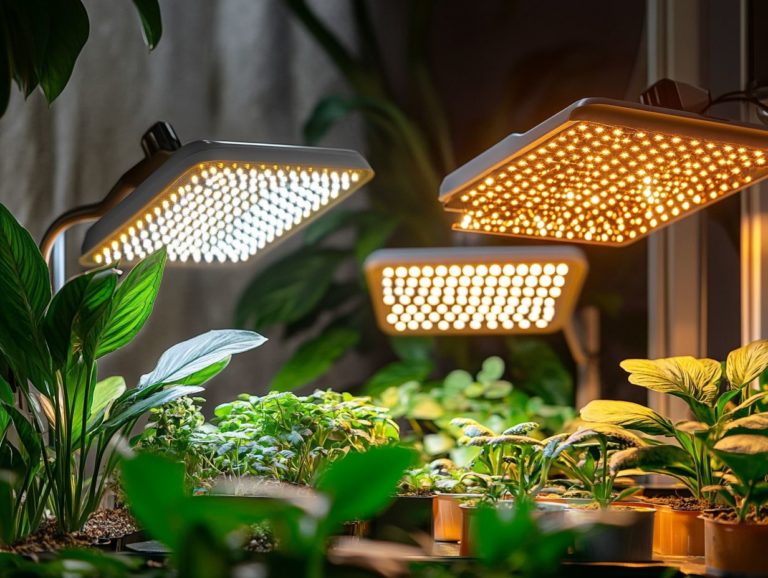Using Light Shades for Indoor Plants
Indoor plants infuse your living spaces with life and vibrancy. Their well-being often depends on the right lighting conditions.
Light shades serve as essential tools that enhance plant growth while protecting them from excessive light.
This article delves into the myriad benefits of using light shades for your indoor greenery. It explores various materials and designs available, guiding you in selecting the perfect shade for your plants.
You’ll also find practical tips for installation and maintenance to ensure your indoor garden flourishes effortlessly.
Discover how to keep your indoor garden thriving!
Contents
- Key Takeaways:
- What are Light Shades?
- Benefits of Using Light Shades for Indoor Plants
- Explore Different Types of Light Shades for Your Plants
- Choosing the Right Light Shade for Your Indoor Plants
- Installing and Maintaining Light Shades for Indoor Plants
- Frequently Asked Questions
- What are light shades and why are they useful for indoor plants?
- What types of light shades are best for indoor plants?
- How do I know if my indoor plants need more or less light?
- Can I use regular household lamps as light sources for my indoor plants?
- Do I need to adjust the light shades for my indoor plants as the seasons change?
- Are there any other benefits to using light shades for indoor plants?
Key Takeaways:
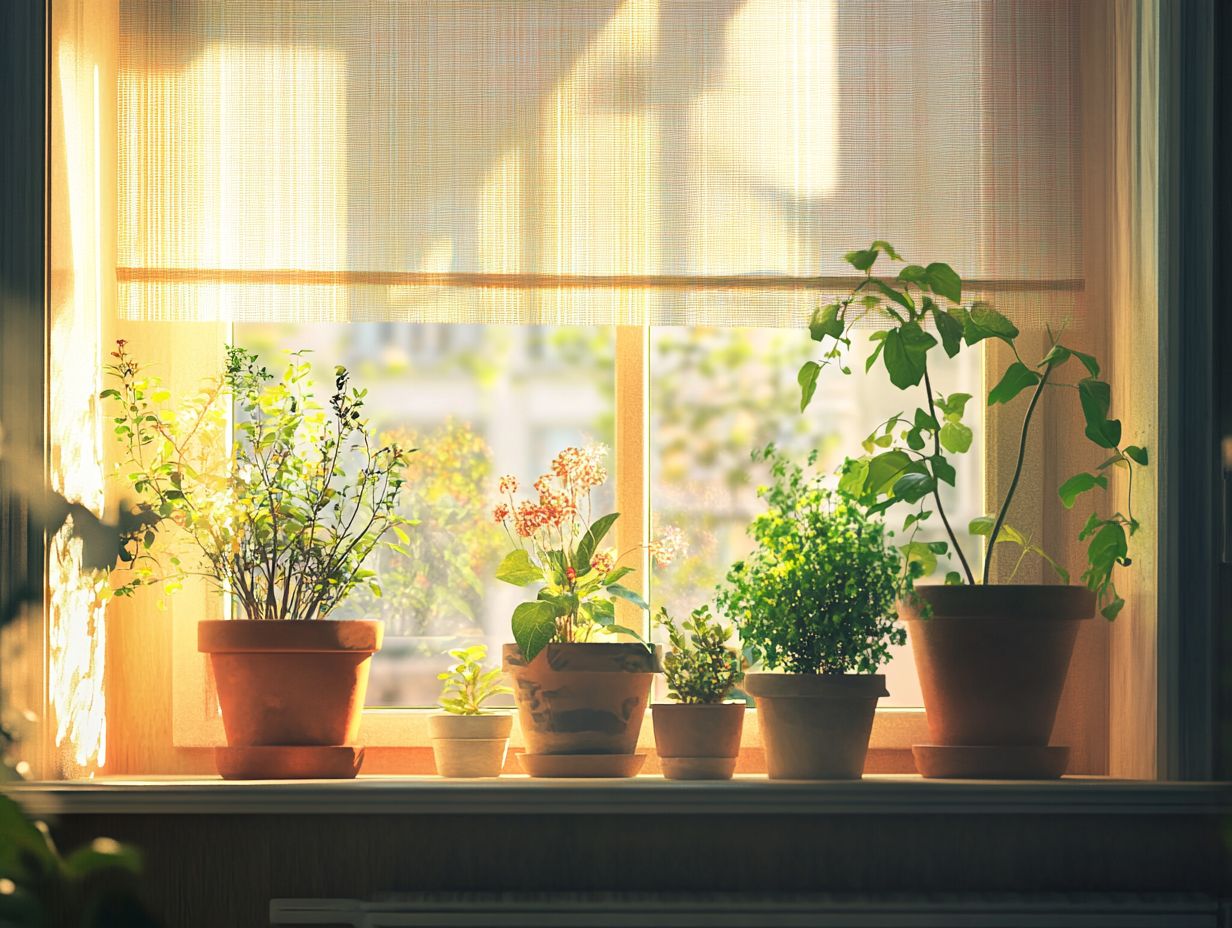
- Using light shades for indoor plants greatly benefits their growth and health by providing the perfect amount of light and protection from harsh sunlight.
- There are various types of light shades available, each with different materials and designs to match your style and your plants’ needs.
- When choosing the right light shade for your indoor plants, consider their light requirements, size, and location in your home. Regular maintenance and proper installation are key to effectiveness.
What are Light Shades?
Light shades are critical accessories for your indoor plants. They help regulate light exposure.
These fixtures ensure that your plants receive the right amount of light they need to flourish, especially in indoor settings where natural sunlight can vary.
By incorporating light shades, you create optimal lighting conditions tailored to the unique needs of your houseplants. Whether they thrive in bright indirect light or need protection from intense sun, the right shade makes a difference.
With a variety of designs and materials at your disposal, choosing the perfect light shades can significantly enhance photosynthesis and promote vibrant leaf growth.
Benefits of Using Light Shades for Indoor Plants
Utilizing light shades for your indoor plants offers numerous benefits that enhance their growth and overall health. These advantages include improved light conditions and protection from harsh rays.
By thoughtfully selecting light shades for various plant types, you create an indoor environment that promotes thriving growth and vibrant leaf color. This ensures that each plant receives its necessary light levels for optimal health.
Improved Plant Growth and Health
Light shades can transform your indoor garden into a thriving oasis! They optimize light quality and duration, enhancing photosynthesis and resulting in healthier leaves and vibrant colors.
With the right light conditions, your houseplants can thrive, becoming more resilient against pests and diseases. Light quality, especially the variety of light, is essential in the photosynthesis process.
You may notice that popular houseplants like the fiddle leaf fig and pothos respond exceptionally well to improved light conditions, showcasing lush, vibrant foliage when they receive the perfect balance of sunlight.
These shades filter harsh rays while allowing beneficial wavelengths to penetrate, creating a nurturing environment for growth. Adjustments can lead to impressive attributes such as increased leaf size and strength, resulting in flourishing plants that enhance the beauty of any indoor space.
For more tips on selecting the right light shades and caring for your indoor garden, visit our website!
Protection from Harsh Light
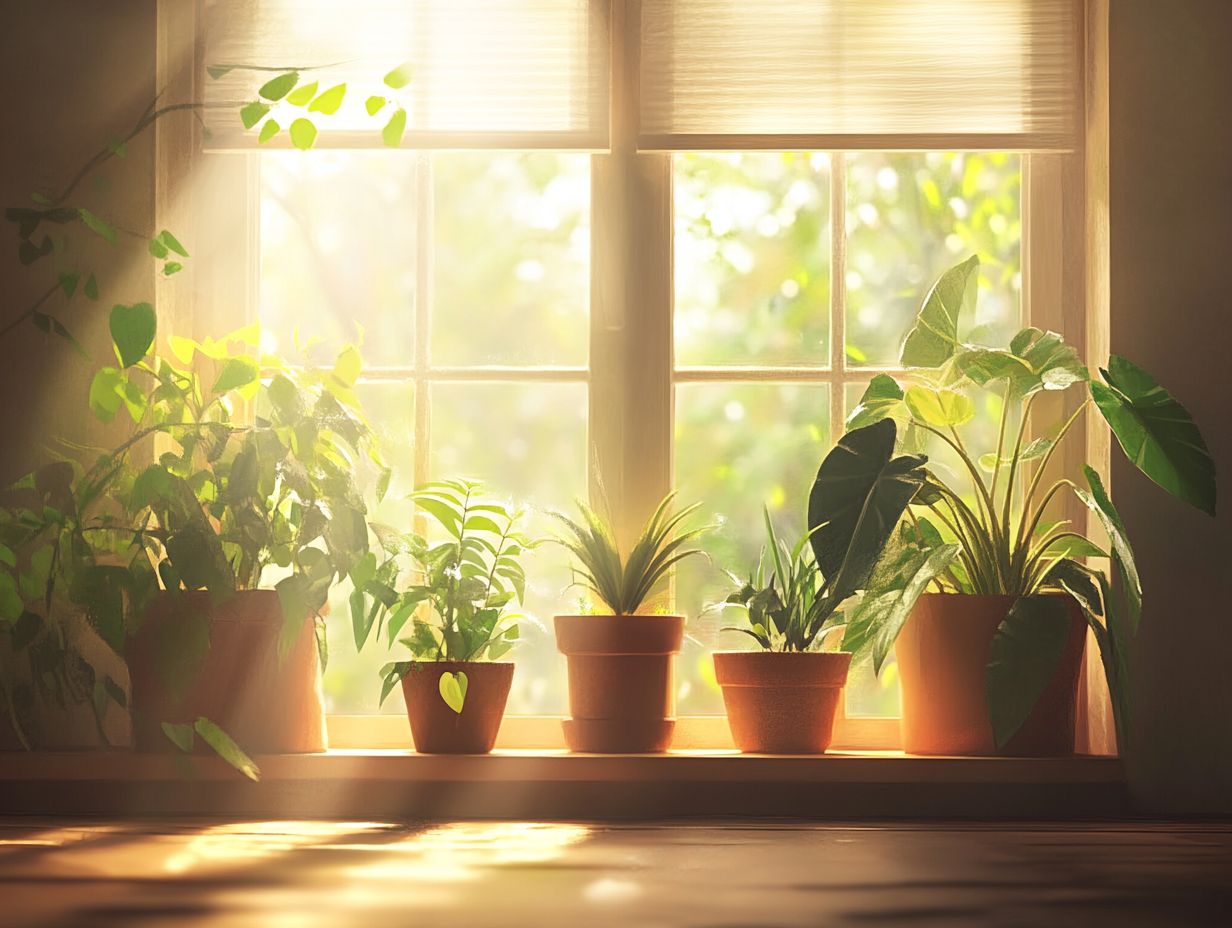
Protection from harsh light is essential for maintaining the health of your indoor plants, especially delicate species that are sensitive to direct sunlight. Without adequate shielding, your plants may suffer from leaf burn and decreased vitality when exposed to intense light levels.
Light shades are coverings that control light exposure for plants. They serve as an effective solution, filtering and diffusing harsh sunlight to create a balanced environment where your plants can adapt and thrive without distress.
Ferns and orchids thrive when protected from harsh light it s essential for their health! By strategically placing light shades, you can prevent the scorching effects of direct sun that often lead to faded leaf colors and stunted growth.
These shades safeguard your plants and cultivate an environment conducive to photosynthesis. This promotes better nutrient absorption. When your plants receive optimal light conditions, they tend to showcase vibrant foliage and blooms, enhancing the overall aesthetics of your interior spaces while contributing to a healthier indoor ecosystem.
Explore Different Types of Light Shades for Your Plants
When selecting light shades for your indoor plants, it’s crucial to consider the variety of options available. Each option is tailored to meet specific light sources and plant needs.
From sheer fabrics that permit bright indirect light to thicker materials that shield against harsh rays, your choice of light shades significantly influences the environment you create for your plants.
Understanding the different materials and designs can help you optimize light conditions. This fosters enhanced growth for your indoor greenery.
Different Materials and Designs
Light shades are available in many materials and designs. Each one is tailored to meet the specific needs of your indoor plants. Picture sheer fabrics that gracefully diffuse light, offering a gentle embrace for your greenery. Thicker materials filter light more robustly, ensuring your plants receive just the right amount without feeling overwhelmed.
The design of these light shades is equally important. It enhances the overall aesthetic of your space while optimizing light conditions for your plants.
Consider bamboo shades; they infuse a rustic charm into your home while effectively blocking harsh sunlight. This makes them perfect for your sun-sensitive plants. On the flip side, metal shades deliver a sleek, modern aesthetic while directing light downward, ensuring it reaches your plants efficiently.
Glass shades, particularly frosted varieties, create a beautiful diffuse effect that mimics natural light vital for the thriving growth of foliage. Every option, whether it’s a soft linen or an ornate ceramic, significantly impacts light exposure. This underscores the importance of choosing the right light shade for your plants’ optimal health, as highlighted in our guide on using sunlight for indoor plants effectively.
Choosing the Right Light Shade for Your Indoor Plants
Selecting the perfect light shade for your indoor plants is about grasping their individual light requirements and determining the optimal window placement in your home.
Various plant types, like cacti and succulents, thrive under distinct light conditions, ranging from bright sunlight to more subdued environments.
By carefully evaluating the specific lighting scenarios within your space, you can choose the right light shades that foster an atmosphere conducive to healthy growth and lush, vibrant foliage.
Wondering how to keep your ferns thriving? Choosing the right light shade today can transform your plant care routine and ensure lush, vibrant growth!
Factors to Consider
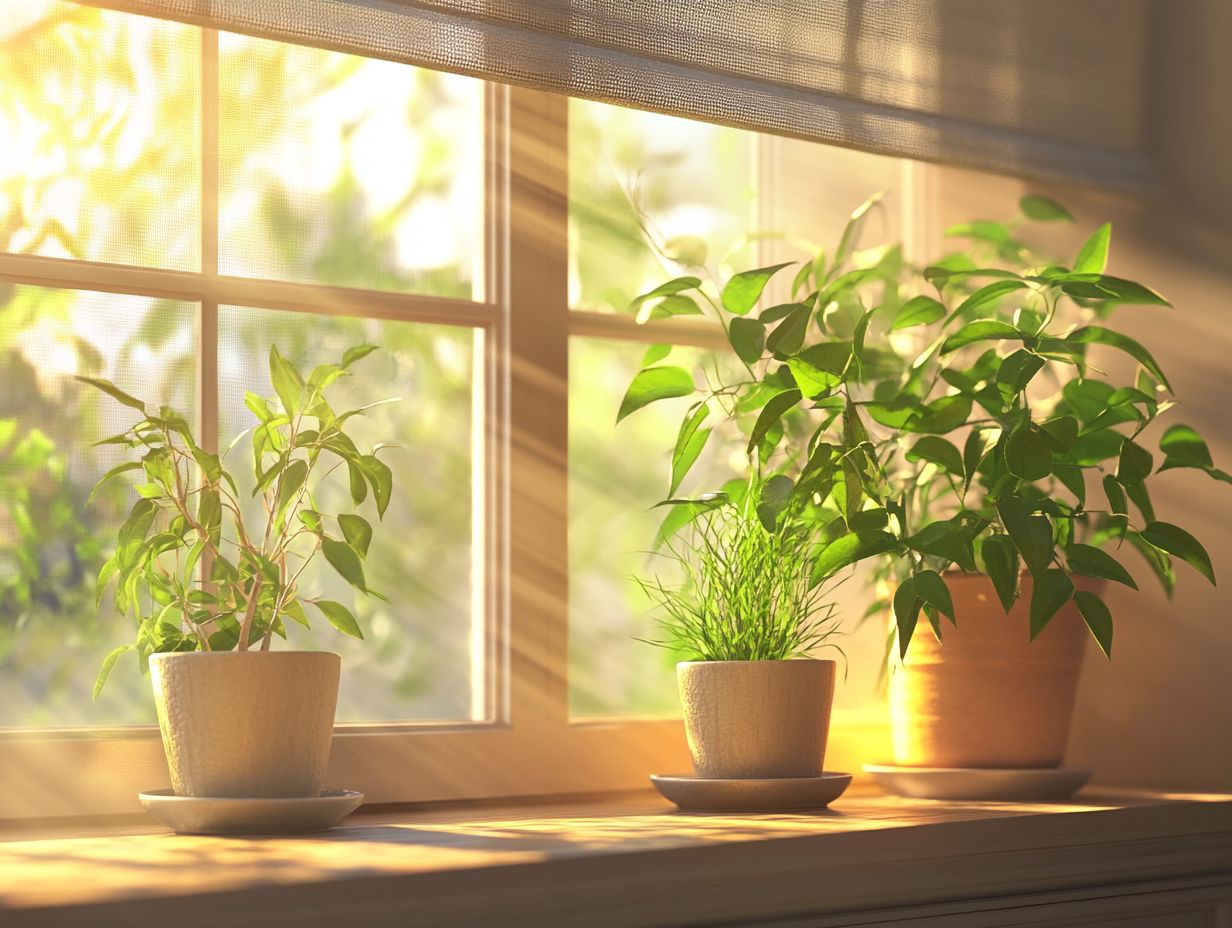
Choose the right light shade for your indoor plants. Consider factors that affect light needs, like light intensity, quality, and duration. These elements are crucial for how effectively your plants can make food and grow. Think about window placement and the types of plants you have, as these will influence the best shade options that promote healthy growth.
Not all plants thrive under the same lighting conditions. For example, succulents generally prefer strong, direct sunlight, so a lighter shade might work for them. On the flip side, ferns and other shade-loving plants flourish in diffused light, making a more opaque treatment preferable to filter the intensity.
Plants need 12 to 16 hours of light each day. Careful planning in your shade choice will help meet this need. Don’t overlook the window’s orientation, either. South-facing windows receive the most light, while north-facing ones offer a gentler glow. Consider this to ensure optimal plant health.
Installing and Maintaining Light Shades for Indoor Plants
Installing and maintaining light shades is crucial for providing the best light to your indoor plants while enhancing their visual appeal. The right installation techniques significantly impact the shades’ effectiveness and the quality of light they deliver.
Regular maintenance is essential to keep the shades clean and functioning well. This ultimately supports the overall health of your indoor plants.
Step-by-Step Guide and Tips
Successfully installing and maintaining light shades can elevate your indoor gardening experience, ensuring your plants flourish in ideal light conditions. Start by selecting the ideal location based on your plants’ specific light needs, and then install the light shades carefully, following the manufacturer’s guidelines.
Regular cleaning and adjustments will help ensure that the shades continue to deliver essential light exposure for robust plant growth. Evaluate each plant’s sunlight preferences, whether they thrive in low, medium, or bright light, to choose shades that expertly filter and distribute the best light for indoor plants.
Light shades come in various materials, such as sheer fabrics or reflective metals, each affecting light intensity uniquely. Once installed, observe your plants responses over time. Adjust the position or angle of the shades to prevent burning or inadequate light exposure.
Using timers can also help maintain a consistent light schedule, seamlessly fitting into your routine while enhancing the overall health and vitality of your indoor garden.
Frequently Asked Questions
What are light shades and why are they useful for indoor plants?

Light shades are coverings that limit the amount of light entering a space. For indoor plants, they help control the amount and intensity of light, ensuring the plants get what they need for optimal growth.
What types of light shades are best for indoor plants?
There are many types of light shades, including sheer fabrics, translucent plastic (which allows some light to pass through), and tinted glass. The best type for your plants depends on their specific light requirements and your home s lighting conditions.
How do I know if my indoor plants need more or less light?
Each plant has different light needs, so it’s important to research your specific plants. A good rule of thumb is to monitor their color and growth. If they appear pale or don t grow well, they may need more light. If they turn yellow or become leggy, they may be getting too much light.
Start choosing the right light shade today to see your plants thrive!
Can I use regular household lamps as light sources for my indoor plants?
Yes, you can use regular lamps as light sources for your indoor plants. However, be mindful of the type of light they emit. Incandescent lights can produce too much heat, which can harm your plants. Instead, opt for LED or fluorescent lights for a balanced light source.
Do I need to adjust the light shades for my indoor plants as the seasons change?
Yes, as the seasons shift, the brightness of natural light changes too. Adjust your light shades to ensure your plants receive the right amount of light. Use lighter shades in winter when natural light is scarce, and darker shades in summer when light is abundant.
Are there any other benefits to using light shades for indoor plants?
Light shades not only control light but also protect plants from direct sunlight, preventing sunburn. They help maintain temperature and humidity, creating a thriving environment for your plants!

